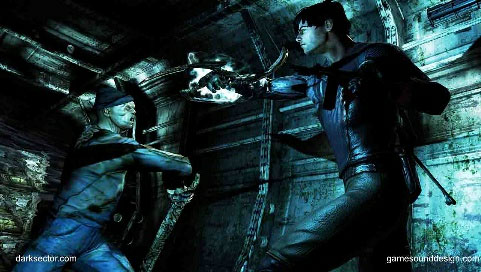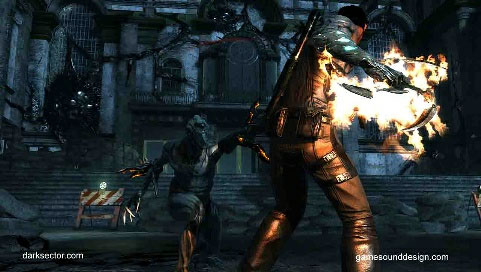Stay Up To Date With Us!
We will never spam you or share your email address.
Game Sound Design Strategies
GSD StrategiesCheck out the gamesounddesign.com strategies when you are feeling creatively uninspired. Each random strategy will present you with a new avenue to pursue. Give them a try!
Game Sound Design Glossary
GSD GlossaryOur game audio glossary has all the sound terms you have been wondering about. Game audio can be confusing enough without having to deal with a new technical language. We are constantly updating the database with new terms that relate to not only game audio but game developer terms as well.
darkSector Video Game Postmortem
Article by George Spanos and Dustin Crenna
Dark Sector is a third person action shooter that thrusts you into Hayden Tenno's mysterious world. You are a covert black-ops agent sent to eradicate a plague that is infecting the once glorious city of Lasria. It quickly becomes apparent that there are some dark secrets about Lasria that probably should have been left alone.
Defining Themes
The first musical challenge that we faced with Dark Sector was defining what we wanted Hayden's theme to be. He is a modern day hero but we didn't want to go too far into a typical 'super hero' theme. We wanted it to combine really dark and moody elements but not go over that magical line that would define it as being too over the top. There were a number of demos that were submitted to us but the one that really stuck out was Keith Power's.
We knew that we had moments of extremely high action to moments of nerve-wracking anticipation. The way we approached this was to write 'sets' of musical pieces. There were straight ahead action oriented combat pieces featuring fast drumming and orchestral instruments; moderately paced pieces featuring various percussion instruments that told the player not to let his/her guard down just yet; ambient pieces featuring synth pads and sound design elements that helped to heighten the creepiness of Hayden's explorations. All of these varieties had to come together to reflect the current atmosphere.
Implementation
It can be very difficult to create musical movement and limit repetitiveness in a video game. Gone are the days of looping a piece of music infinitely. Being able to jump between different music sets seamlessly was something we tried to accomplish and were fairly successful at. Using themed groups of music for ambience, light combat and heavy combat allowed us another level of customizing the events that the player would be experiencing on screen. Another way of limiting musical repetitiveness was the use of triggered volume envelopes and cross fades of different pieces. The structure of a lot of the battles in Dark Sector was such that we were able to put specific instructions into our engine (the Evolution Engine) that reacted to what the player was experiencing.

For example, when finishing up a battle with several enemies we would fade out the current piece of music (that has been edited for action) and then crossfade an ending that tells the player that they have disposed of all nearby enemies. This is a simple but important piece of information that tells the player that they have completed the current objective. There were numerous ways we could go about setting up this scenario. From something as simple as placing a trigger to override the current music set, or something much more in-depth as detecting whether all the A.I. have been eliminated or not. It really depended on what the situation called for, and which method would be as seamless as possible for the moment. A good example of this whole system in action would be the moments when the player finds themselves surrounded by the infected, zombie-like characters in the game. We were able to use a more 'Silent Hill' approach to the cues and have more noise and sound design elements play than actual thematic music. It worked very well for these situations causing panic and a sense of fear, and being non-musical they blended well with Keith's musical score.
Sound Design And Music
The sound design of Dark Sector was also really important to the storytelling. We created a number of ambient sound design pieces that combined traditional musical instrumentation with elements of sound design. It was really effective to infuse the pieces with sounds that made the player feel on-edge. Things like prepared piano scrapes, metal creaks and groans, as well as infusing some of the scarier NPC sounds into the music. These sound design cues allowed us to help the player perceive that the infection was spreading throughout their body through the use of audio. Altering the state of the soundscape to not include what you'd traditionally hear brought about a sense of unease. We would create a list of a few different cues which would play randomly and constantly, but at the same time it didn't feel like the cues were switching at all. It helped with the immersion factor that there were no jarring and noticeable cue changes. It also helped to avoid creating any musical fatigue by not having to play the same tracks over and over again.
Challenges
The production of Dark Sector wasn't without its fair share of pitfalls, though. One major obstacle that we ran into with the music implementation was the fact that the timing for our cinematics wasn't fully locked down before Keith scored them. Quite often we had to edit his score to fit the newly arranged timings. Whole shots would get cut-out and lines of dialogue would be cut. It's important to have as close to final timings as possible before writing music.

Our dynamic music system is still in its infancy and we have a ton of ideas that we'd like to implement. While we were able to dynamically crossfade music we were not able to mix and match cues together based on gameplay. For example, having the ability to trigger a musical breakdown that plays underscore in response to gameplay changes, then switching to a different melody when the action heats up again etc... would have enabled us to incorporate even more control over the moment to moment feel of Dark Sector.
Conclusions
Quite often the line between sound design and traditional music can be blurred. The most important thing to consider when creating audio is to achieve cohesiveness. This is done by defining the setting, characters, and story, then coming up with a clear picture of what the music and the sound design's role will be in the game. If you can immerse a player into the world you've created through the use of audio and at the same time make the player unaware of the changes going on behind-the-scenes, then you've successfully created an overall experience rather than just a few cool moments. We believe that we've created an experience with Dark Sector.

